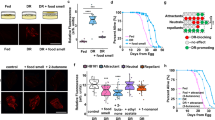Abstract
Research successes over the past decade have provided a broad outline of the neuroscience of olfaction and taste. Our understanding of these systems now spans the molecular to the psychological. It will soon reach critical mass and begin to generate a variety of practical applications with commercial potential. Given the ubiquity of smell and taste and their importance to health, nutrition and quality of life, these applications could have a major impact on consumer product markets and create entirely new ones. Sensory biotechnology could be the first post-genomic application to break through to the consumer market. We describe odor modulation technologies with implications for food intake, health care and other arenas. Our deeper understanding of olfaction and taste in animal behavior and reproduction provides opportunities in pest control and animal husbandry, where environmentally neutral interventions are much in demand.
This is a preview of subscription content, access via your institution
Access options
Subscribe to this journal
Receive 12 print issues and online access
$209.00 per year
only $17.42 per issue
Buy this article
- Purchase on Springer Link
- Instant access to full article PDF
Prices may be subject to local taxes which are calculated during checkout

Similar content being viewed by others
References
Buck, L. & Axel, R. A novel multigene family may encode odorant receptors: a molecular basis for odor recognition. Cell 65, 175–187 (1991).
Mombaerts, P. Seven-transmembrane proteins as odorant and chemosensory receptors. Science 286, 707–711 (1999).
Glusman, G., Yanai, I., Rubin, I. & Lancet, D. The complete human olfactory subgenome. Genome Res. 11, 685–702 (2001).
Zozulya, S., Echeverri, F. & Nguyen, T. The human olfactory receptor repertoire. Genome Biol. 2, research0018.1–0018.12 (2001).
Malnic, B., Hirono, J., Sato, T. & Buck, L.B. Combinatorial receptor codes for odors. Cell 96, 713–723 (1999).
Nelson, G. et al. Mammalian sweet taste receptors. Cell 106, 381–390 (2001).
Chandrashekar, J. et al. T2Rs function as bitter taste receptors. Cell 100, 703–711 (2000).
Montmayeur, J.P., Liberles, S.D., Matsunami, H. & Buck, L.B. A candidate taste receptor gene near a sweet taste locus. Nat. Neurosci. 4, 492–498 (2001).
Nelson, G. et al. An amino-acid taste receptor. Nature 416, 199–202 (2002).
Chaudhari, N., Landin, A.M. & Roper, S.D. A metabotropic glutamate receptor variant functions as a taste receptor. Nat. Neurosci. 3, 113–119 (2000).
Zhao, H. et al. Functional expression of a mammalian odorant receptor. Science 279, 327–242 (1998).
Wysocki, C.J., Pierce, J.D. Jr. & Gilbert, A.N. in Smell and Taste in Health and Disease (eds. Getchell, T. V., Bartoshuk, L. M., Doty, R. L. & Snow, J. B. Jr.) 287–314 (Raven, New York, 1991).
Wysocki, C.J. & Beauchamp, G.K. Ability to smell androstenone is genetically determined. Proc. Natl. Acad. Sci. USA 81, 4899–4902 (1984).
Segal, N.L., Topolski, T.D., Wilson, S.M., Brown, K.W. & Araki, L. Twin analysis of odor identification and perception. Physiol. Behav. 57, 605–609 (1995).
Gilbert, A.N. & Kemp, S.E. Odor perception phenotypes: multiple, specific hyperosmias to musks. Chem. Senses 21, 411–416 (1996).
Jacob, S. & McClintock, M.K. Psychological state and mood effects of steroidal chemosignals in women and men. Hormones Behav. 37, 57–78 (2000).
Graham, C.A., Janssen, E. & Sanders, S.A. Effects of fragrance on female sexual arousal and mood across the menstrual cycle. Psychophysiology 37, 76–84 (2000).
Jacob, S., McClintock, M.K., Zelano, B. & Ober, C. Paternally inherited HLA alleles are associated with women's choice of male odor. Nat. Genet. 30, 175–179 (2002).
Clyne, P. et al. A novel family of divergent seven-transmembrane proteins: candidate odorant receptors in Drosophila. Neuron 22, 327–338 (1999).
Vosshall, L.B., Amrein, H., Morozov, P.S., Rzhetsky, A. & Axel, R. A spatial map of olfactory receptor expression in the Drosophila antenna. Cell 96, 725–736 (1999).
Author information
Authors and Affiliations
Corresponding author
Rights and permissions
About this article
Cite this article
Gilbert, A., Firestein, S. Dollars and scents: commercial opportunities in olfaction and taste. Nat Neurosci 5 (Suppl 11), 1043–1045 (2002). https://doi.org/10.1038/nn937
Received:
Accepted:
Published:
Issue Date:
DOI: https://doi.org/10.1038/nn937
This article is cited by
-
The scent of attraction and the smell of success: crossmodal influences on person perception
Cognitive Research: Principles and Implications (2021)
-
Computational modeling of the olfactory receptor Olfr73 suggests a molecular basis for low potency of olfactory receptor-activating compounds
Communications Biology (2019)
-
Genes and ligands for odorant, vomeronasal and taste receptors
Nature Reviews Neuroscience (2004)
-
Nephrotoxicity of 4-cycloocten-1-carbaldehyde
Archives of Toxicology (2004)
-
Challenges for the sensory sciences from the food and wine industries
Nature Reviews Neuroscience (2003)



